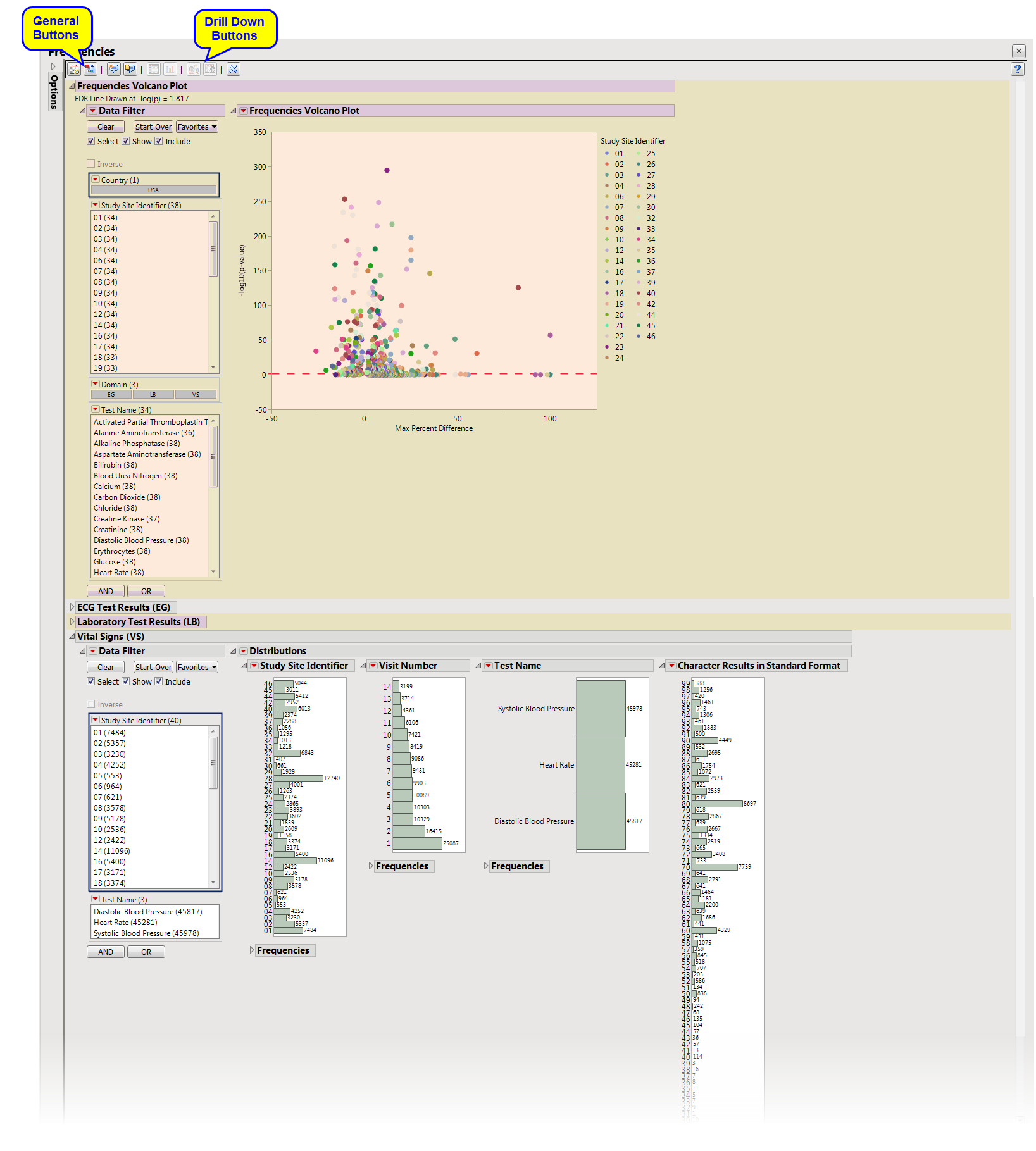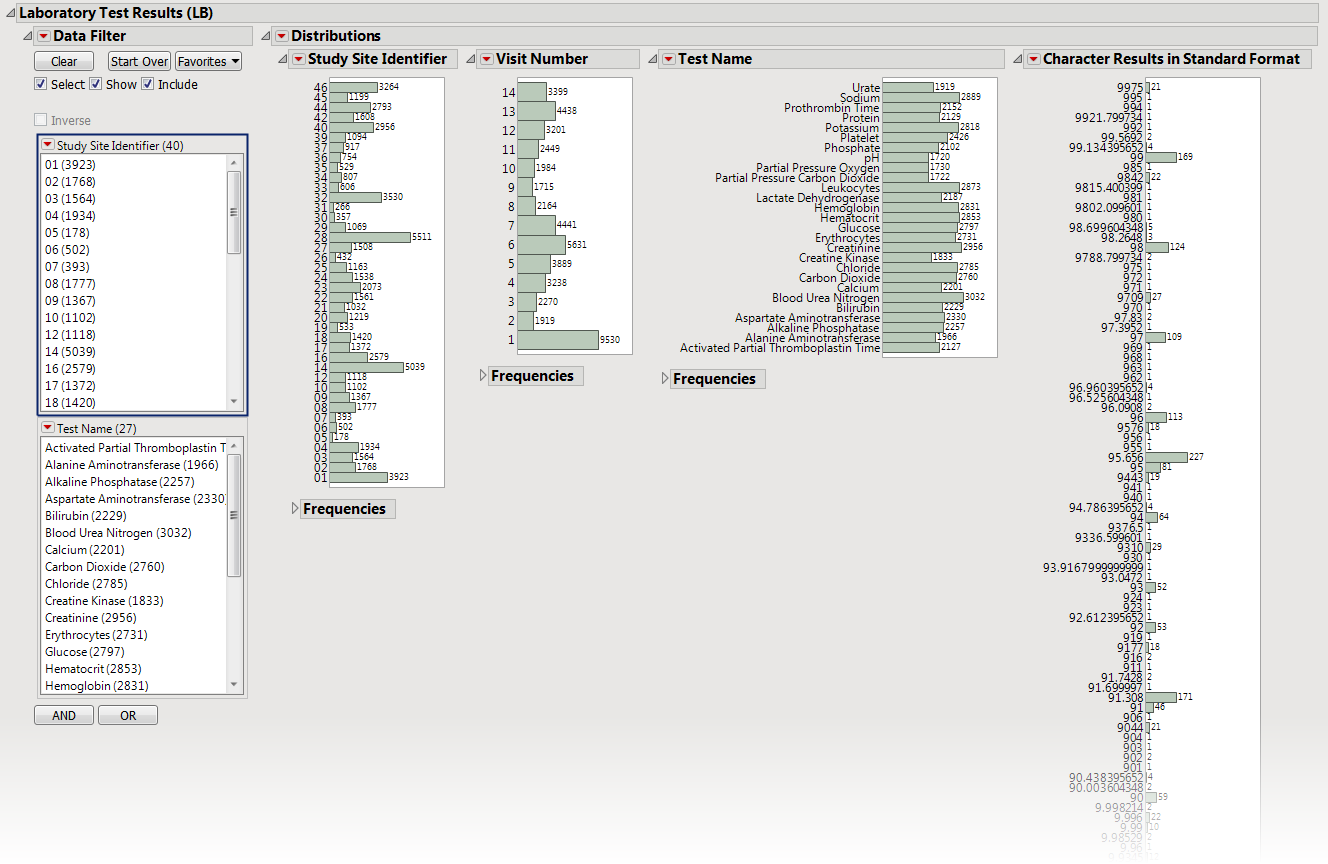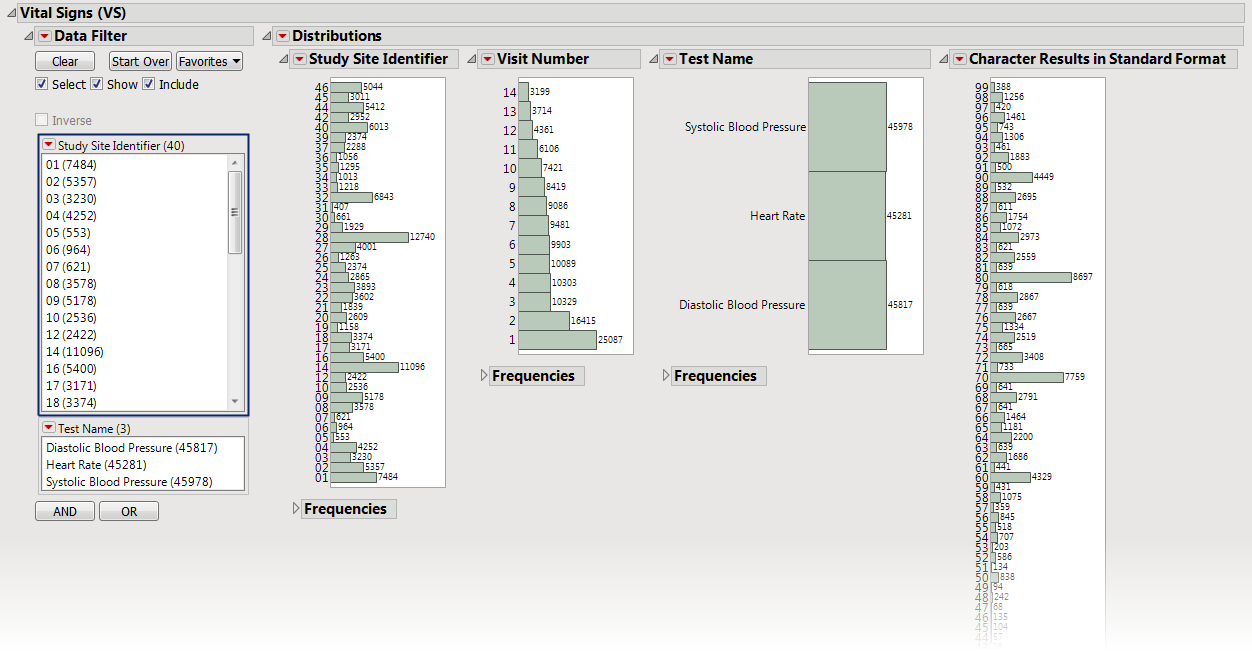Frequencies
This report identifies unusual frequencies across the entire study or by study visit. This analysis is typically used on categorical variables, though an analysis on continuous outcomes can identify an over- or under-representation of certain values at a site compared to other sites.
Note: JMP Clinical uses a special protocol for data including non-unique Findings test names. Refer to How does JMP Clinical handle non-unique Findings test names? for more information.
Report Results Descriptions
Running this report with the Nicardipine sample setting generates the report shown below.

The Report contains the following elements:
Frequencies Volcano Plot
Shows a volcano plot used to determine the deviation of the proportion of findings frequencies at each site with the overall proportions for the findings across the whole study.

| • | One Data Filter. |
Enables you to subset subjects based on country of origin, study site and/or Test. Refer to Data Filter for more information.
| • | One Volcano Plot. |
The volcano plot is used to determine the deviation of the proportion of findings frequencies at each site with the overall proportions for the findings across the whole study. Each “bubble” represents a single Findings test for a specific site, which is compared to a reference (all other sites).The X axis represents the maximum difference in proportions between each value of the Findings test between the site and the reference set (all other sites).
You can mouse over points of interest to see their labels or select points by dragging a mouse rectangle over them (as shown above). Selected rows are highlighted in other plots and you can also then click on various Down Buttons for further analyses on those specific sites. For example, if you click  , the following opens with comparisons of sites 18 and 40 with all sites not site 18 or 40, respectively.
, the following opens with comparisons of sites 18 and 40 with all sites not site 18 or 40, respectively.
ECG Test Results
Displays histograms summarizing ECG findings across the study.

This section contains the following elements.
| • | Data Filter: Enables you to filter data based on study site and country. |
| • | Distributions: Displays histograms showing distribution of ECG findings across study sites, tests, and visit numbers, study sites, categories, and tests. |
Laboratory Test Results
Displays histograms summarizing lab test findings across the study.

This section contains the following elements.
| • | Data Filter: Enables you to filter data based on study site and country. |
| • | Distributions: Displays histograms showing distributions of laboratory test findings across study sites, tests, and visit numbers, and tests. |
Vital Signs
Displays histograms summarizing vital signs findings across the study.

This section contains the following elements.
| • | Data Filter: Enables you to filter data based on study site and country. |
| • | Distributions: Displays histograms showing distribution of vital signs findings across study sites, tests, and visit numbers, |
Action Buttons
Action buttons, provide you with an easy way to drill down into your data. The following action buttons are generated by this report:
| • | Show Sites: Shows the rows of the data table for the selected points from the volcano plot. Clicking  opens the following table: opens the following table: |

| • | Frequency Bar Chart: Select points on the volcano plot and click  to display a bar chart for each point showing the proportions of each value of the Findings Test for the site as compared to the distribution of all of the other sites combined. to display a bar chart for each point showing the proportions of each value of the Findings Test for the site as compared to the distribution of all of the other sites combined. |
| • | Patient Profiles: Select subjects and click  to generate the patient profiles. See Patient Profiles for additional information. to generate the patient profiles. See Patient Profiles for additional information. |
| • | Show Subjects: Select subjects and click  to open the ADSL (or DM if ADSL is unavailable) of selected subjects. to open the ADSL (or DM if ADSL is unavailable) of selected subjects. |
General and Drill Down Buttons
Action buttons, provide you with an easy way to drill down into your data. The following action buttons are generated by this report:
| • | Click  to reset all report options to default settings. to reset all report options to default settings. |
| • | Click  to view the associated data tables. Refer to Show Tables/View Data for more information. to view the associated data tables. Refer to Show Tables/View Data for more information. |
| • | Click  to generate a standardized pdf- or rtf-formatted report containing the plots and charts of selected sections. to generate a standardized pdf- or rtf-formatted report containing the plots and charts of selected sections. |
| • | Click  to generate a JMP Live report. Refer to Create Live Report for more information. to generate a JMP Live report. Refer to Create Live Report for more information. |
| • | Click  to take notes, and store them in a central location. Refer to Add Notes for more information. to take notes, and store them in a central location. Refer to Add Notes for more information. |
| • | Click  to read user-generated notes. Refer to View Notes for more information. to read user-generated notes. Refer to View Notes for more information. |
| • | Click  to open and view the Review Subject Filter. to open and view the Review Subject Filter. |
| • | Click  to specify Derived Population Flags that enable you to divided the subject population into two distinct groups based on whether they meet very specific criteria. to specify Derived Population Flags that enable you to divided the subject population into two distinct groups based on whether they meet very specific criteria. |
Methodology
This report compares the observed distribution of categorical tests with each site compared to all other sites taken together as a reference, ordering by numeric equivalent if available. For example, if character variable lists none, mild moderate, severe, very severe with corresponding numeric value (xxSTRESN) listed as 0, 1, 2, 3, 4, the intended order of the column variable levels are maintained.
|
|
l1 |
l2 |
... |
lJ |
|
Suspect |
|
|
|
|
|
Others |
|
|
|
|
Calculate a general chi-square test for association (Stokes et al., 20121),

FDR p-values are calculated and the reference line is determined as described in How does JMP Clinical calculate the False Discovery Rate (FDR)?.
Report Options

Findings Analysis
By default the report is set to analyze all tests from all findings domains. You can opt however, to restrict the search to specific Findings Tests.
You can specify whether to search all results in original units when you Analyze: the data or restrict the search to either character results (in standard format) or numeric results (in standard units).
Use the Summarize tests with this many levels or fewer: option to specify the maximum number of distinct levels or values a findings test may have to be included in the analysis (a findings test must have at least 2 levels). The number of levels is determined based on the selected variable of analysis.
You can opt to Consider BY variables in the analysis. This option, which assumes that BY variables (left vs. right arm for collecting blood pressure data, for example) are included in the experimental design, is selected by default. You can uncheck this option to ignore BY variables.
Use the Only include BY variables if they are domain keys option to subset the available variables to only include those variables that are domain keys. If the option is unchecked, the report uses the cross-classification of xxCAT, xxSCAT, xxLOC, xxMETHOD, xxPOS, xxSPEC, and xxTPT for creating by groups for all variables that are available (as it had in the past).
The Summarize sites with at least this many subjects: option enables you to set a minimal threshold for the sites to be analyzed. Only those sites which exceed the specified number of subjects are included. This feature is useful because it enables you to exclude smaller sites, where small differences due to random events are more likely to appear more significant than they truly are. In larger sites, observed differences from expected attendance due to random events are more likely to be significant because any deviations due to random events are less likely to be observed.
Selecting the Generate summary statistics by visit option enables you to summarize the specified findings from the sites that meet the specified criteria.
You might or might not want to include unscheduled visits when you are analyzing findings by visit. Check the Remove unscheduled visits to exclude unscheduled visits.
The Alpha option is used to specify the significance level by which to judge the validity of the model generated by this report. By definition, alpha represents the probability that you will reject the null hypothesis when the null is, in fact, true. Alpha can be set to any number between 0 and 1, but is most typically set at 0.01, 0.05, or 0.10. The higher the alpha, the lower your confidence that the results you observe are correct.
Filtering the Data:
Filters enable you to restrict the analysis to a specific subset of subjects and/or adverse events, based on values within variables. You can also filter based on population flags (Safety is selected by default) within the study data.
See Select the analysis population, Select saved subject filter2, and Additional Filter to Include Subjects
The Subset of Visits to Analyze options enables you to restrict to a specific subset of visits.